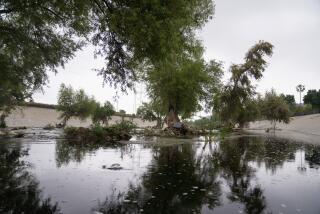The Missouri River Gains a Gruesome Reputation : Crime: The famous waterway, so important in the opening of the Western frontier, now has a sinister side. It has become a dumping spot for corpses.
- Share via
KANSAS CITY, Mo. — The mighty Missouri River, often jokingly described as too thick to drink and too thin to plow, is becoming as notorious as the East River in New York City.
Both are convenient places for killers to dump the bodies of their victims.
Law enforcement officers in the Kansas City area say they are finding too many bodies floating in its murky, churning currents, including the bodies of women who have had their legs cut off.
In the frontier days, pioneers, traders and explorers traversed the Missouri, the second-longest river in the United States. Barge shippers still depend on the waterway to move their wares.
Now the Big Muddy around Kansas City has emerged as a secluded, silent and efficient helper to killers.
“It’s easier than trying to bury one, for the most part,” said Cpl. Charles Bent of the Missouri Water Patrol. “The river is easy to access, and then the bodies float downstream, out of the area.”
Once or twice a year, Bent said, the water patrol is called out to help search for bodies in the river, not counting the victims of drowning and other accidental deaths.
He speculates that killers are drawn to the river because many of its banks and bridges are secluded.
“Depending on where they dump a body, the odds of someone seeing it are rather slim,” he said.
But not always.
“I think people think when bodies are thrown in there they just disappear,” said Bob Teichman, sheriff of Lafayette County, one of several counties in the Kansas City area bordering the river.
“They think they’re getting rid of the evidence--which sometimes they do,” Teichman said. “But in the last 10 years, we’ve probably pulled out about 10 or more bodies.”
Kansas City Police Department Capt. Vince McInerney said officers find several bodies a year in the river running through the city, but he could not provide numbers.
Police now are working on at least seven killings of women since 1982 in which the bodies were found in the river.
McInerney predicts that no matter how many bodies wash up, killers will continue throwing them in the river.
The FBI, which profiles certain types of killers, says some decide where to dispose of a body according to fantasies they’ve had about committing murder.
“Some of them are so good at it that they find the body disposal site before they find the victim,” said Mike Napier with the behavioral science unit of the FBI in Kansas City. “They have very, very active fantasy lives, starting at incredibly young ages.”
“When the situation that presents itself fits the fantasy the killer will act,” Napier said.
Killers who dump bodies in rivers generally hope the evidence will be carried away or disappear, Napier said.
Bent agrees, saying killers are drawn to the river because the water can break down corpses, and then wash them away.
Dr. Michael Berkland, the Jackson County medical examiner, says body tissues break down under water, forming gases that eventually float corpses to the surface. But the longer bodies are submerged, the more difficult identification becomes later.
“You end up having to rely on dental records,” he said.
If a body is dismembered, identifying parts that surface separately can be difficult “unless there was some sort of prior injury or defect you had documented,” Berkland said.
In September, Kansas City police pulled the remains of the latest known murder victim from the river. Viola McCoy is considered one in a series of women killed by someone who surgically removed the legs of four victims before tossing their bodies in the river.
McCoy’s was the fourth mutilated female body pulled from the river since August, 1986, when authorities found Melody Milliner’s legless remains.
In May, 1988, Kimberly Rash’s torso and legs were pulled from the river; and the legless body of 13-year-old Beverlie Tracy was discovered in April, 1991.
Kansas City police in November spent three days searching the four-acre property of a Platte County man, looking for clues in the mutilation deaths, as well as three others, and the disappearance of an eighth female.
Seven of the bodies were found in the river.
The man has not been charged.
More to Read
Sign up for Essential California
The most important California stories and recommendations in your inbox every morning.
You may occasionally receive promotional content from the Los Angeles Times.













